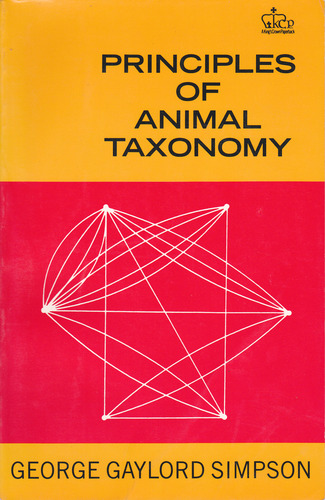Principles of animal taxonomy pdf download
Par banks merrill le jeudi, septembre 15 2016, 00:41 - Lien permanent
Principles of animal taxonomy by George Gaylord Simpson


Principles of animal taxonomy George Gaylord Simpson ebook
Format: djvu
ISBN: 023109650X, 9780231096508
Publisher: Columbia University Press
Page: 131
The principle behind the method is illustrated in Figure 1, which shows a single species splitting into two independently evolving populations that gradually diverge over time. Plant, animal and mineral systematics principles were stated by Karl Linney back in the 18th century. Yeah, it is difficult but it is not boring at all. Okay, so I was talking about FPJ 140 or ZOO 140 (Animal Taxonomy). He studied botany and medicine and Of his higher groupings, only those for animals are still in use, and the groupings themselves have been significantly changed since their conception, as have the principles behind them. Scarcely a decade ago, Simpson (1961) matter-of-factly concluded that for the protists "evolutionary classification is not yet practicable. The following is a brief summary on the principles and advancements of primary genetic markers involved in assessments of Animal Genetic Resources (AnGR). The process of classifying and giving names to plants and animals was extensively studied by Berlin [3] who defines general principles to ethnobiological categorization and nomenclature. New York: Columbia University Press. By method authors mean an arrangement of minerals, plants, and animals according to the principles of logical division. Arthropods are the most diversified animal group [1, 2]. Linnaeus, Carolus (kärō'ləs lĭnā'əs), 1707-78, Swedish botanist and taxonomist, considered the founder of the binomial system of nomenclature and the originator of modern scientific classification of plants and animals. Conversely, protein electrophoresis is a rapid, economic, and straightforward technique and provides a more detailed representation of polymorphisms than morphological or cytological markers; thus, it is still widely used in elucidating the origin and classification of species [10]. Principles of Animal Taxonomy (no.20). Simpson GG (1961) Principles of Animal Taxonomy. We evaluated completeness, accuracy, and historical trend of the taxonomic knowledge on the myrmecophilous ground beetle tribe Paussini (Coleoptera, Carabidae, Paussinae). Homologues, natural kinds and the evolution of modularity. At all times, one of the key tasks of biology as a science was to establish the life form classification – systematics, taxonomy. Most think that taxonomy is boring and difficult. Hunn [13] Our objective, in this study, is to record the fishers' knowledge in relation to cetaceans, with special emphasis on folk taxonomy (ethnotaxonomy), analyzing fishers' forms of classification and nomenclature of whales and dolphins in the Southeastern Brazilian coast.